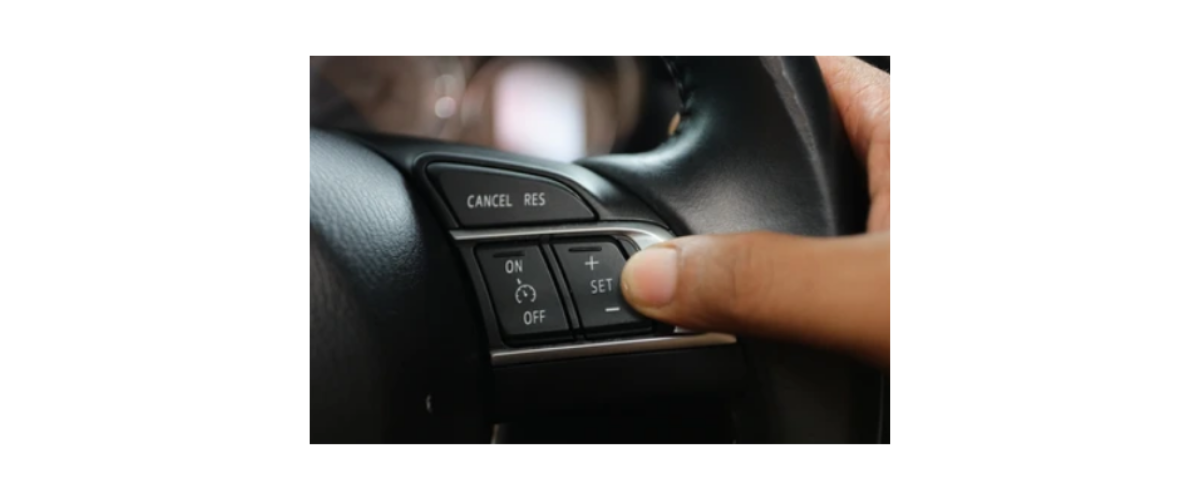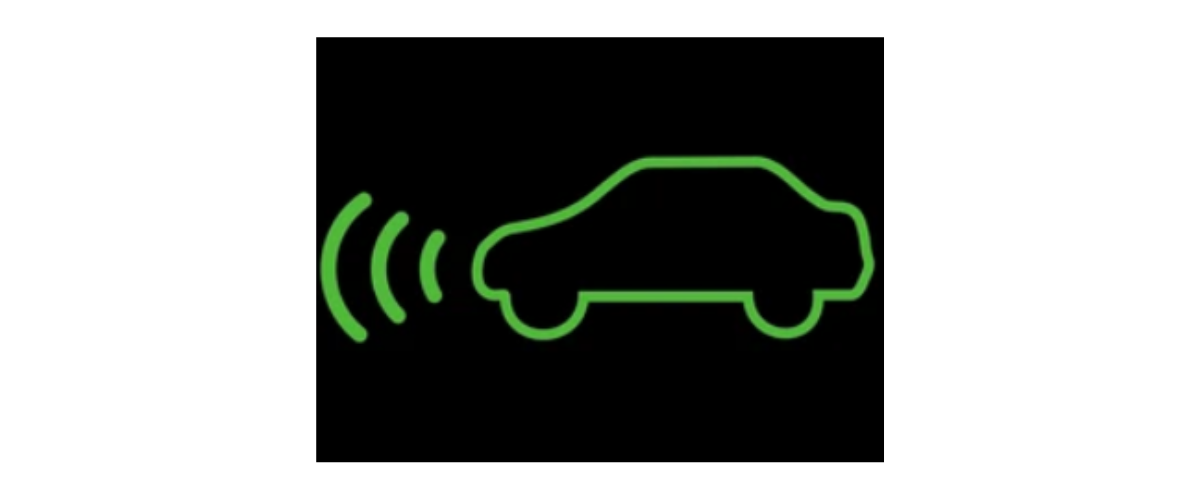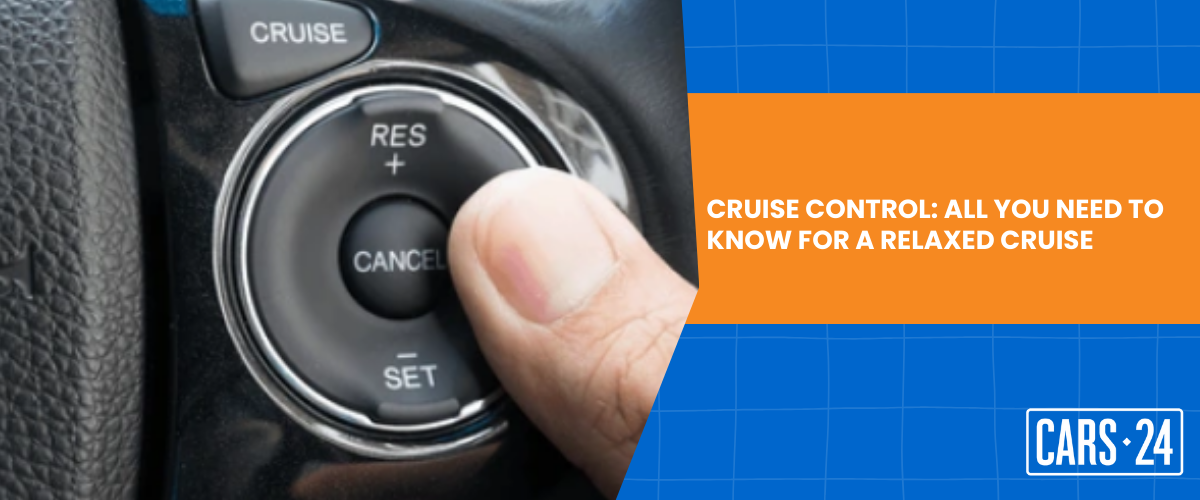Lets be honest! Driving can sometimes feel like a constant game of footsie with the gas pedal. Especially on long stretches of road, your leg can start to feel like it’s running its marathon. To save you from this pedal purgatory, enter, Cruise Control! It is an ingenious innovation that frees drivers from the burden of constantly pressing down on the accelerator. Instead, drivers can let their vehicle take control and maintain a steady speed on its own. Well talk more about cruise control in this blog!
What is cruise control?
Cruise control, a ubiquitous feature in modern automobiles, offers many benefits for drivers embarking on extended journeys. By enabling the maintenance of a consistent speed without manual pedal control, cruise control can significantly alleviate driver tiredness and minimise leg strain, particularly during prolonged highway travel. Additionally, studies have demonstrated the potential of cruise control to optimise fuel efficiency by mitigating the micro-adjustments in pedal pressure that can contribute to increased fuel consumption.
Moreover, advancements in cruise control technology have introduced adaptive cruise control, which employs sensors to adjust vehicle speed based on the preceding vehicle’s distance. This advanced functionality further enhances safety and driver comfort by mitigating the need for constant pedal adjustments in stop-and-go traffic or when maintaining safe following distances.
It is, however, crucial to emphasise that despite the significant advantages offered by cruise control, drivers must remain vigilant and maintain full situational awareness while utilising this technology. Hands should never leave the steering wheel, and undivided attention to the road remains paramount at all times.
How does cruise control work?
Cruise control simplifies driving by automatically managing your vehicle’s speed, eliminating the need for constant foot pressure on the accelerator.
In older cars, such as the 1998 Ford Mustang, cruise control was enabled by directly linking to the throttle valve using a cable. However, in contemporary vehicles, this function is managed electronically. The onboard computer controls engine power by adjusting the air & fuel intake electronically.
This feature ensures a steady pace without the driver experiencing fatigue or distraction, thereby optimising fuel efficiency and reducing the risk of inadvertently exceeding the speed limit and facing penalties.
How to use cruise control?

The cruise control buttons are typically located on the right side of the steering wheel, though their exact position may vary depending on the car make & model. Despite the placement differences, the functions of these buttons remain similar across vehicles. Here’s a rundown of the basic cruise control buttons:
ON/OFF: Press this button to activate cruise control. When activated, a light on the dashboard will indicate the system is on. Press the button again to deactivate the cruise control.
Res +: Use this button to increase your cruising speed. Each press increases the speed by 1 mph. You can also use it to resume your previously set speed.
Set -: This button decreases the set speed. Each press reduces the speed by 1 mph. Once you reach your desired speed, press “Set,” and the “Cruise Set” icon will appear on the dashboard. At this point, you can release the gas pedal, and the car will maintain the speed for you. In some cars, you may have
Cancel: Press this button to disengage cruise control, such as when exiting the highway or encountering heavy traffic. Alternatively, you can cancel the system by pressing the brake pedal.
Does cruise control use the brakes?
Cruise control typically operates by regulating engine power to adjust speed, without the need to engage the brakes for deceleration. This mechanism ensures a seamless driving experience, where the throttle input is modulated to maintain a consistent speed, relieving the driver from constant intervention. However, in vehicles equipped with adaptive cruise control, a more advanced system, the utilisation of brakes becomes an option for speed control under certain circumstances. This feature enhances the adaptability of the cruise control system, allowing it to respond dynamically to changes in traffic conditions.
The primary function of cruise control remains centred around the modulation of throttle input to achieve a steady speed, ensuring efficiency and convenience during highway driving. Nevertheless, in scenarios necessitating immediate disengagement of cruise control, such as encountering unexpected obstacles or alterations in driving conditions, activating the brake pedal provides an effective means to swiftly deactivate the system. This action restores manual control over the vehicle’s speed, empowering the driver to respond promptly to evolving road situations.
What’s the difference between contemporary cruise control and adaptive cruise control?
ACC or adaptive cruise control is a smarter technology in comparison to contemporary cruise control, offering more than just setting a speed. With ACC, you can also choose how far you want to follow the car ahead, giving you greater control over spacing.
Here’s the clever part: When ACC is on, it keeps an eye on the car in front. If that car slows down, ACC automatically slows your car to keep a safe distance. For example, if you set your car to 70mph but the car in front is doing 65mph, ACC smoothly matches that speed. However, if the car ahead speeds up or moves, ACC quickly gets your car back to your chosen speed. It’s like having a thoughtful co-pilot, ensuring a smooth and safe ride.
How Can You Use Cruise Control Effectively?
Using cruise control is most effective on long, straight roads that are mostly flat. It helps maintain your speed with minimal adjustments. However, on hilly or winding roads, it’s better to drive manually. Cruise control doesn’t adapt as quickly as a human driver to changes in terrain.
In bad weather, rough roads, or tight turns, it’s safer to turn off cruise control and drive based on the conditions.
Remember, don’t rely solely on cruise control. Always be ready to brake and take control if needed. Different conditions like wet roads or heavy traffic may require faster reactions than cruise control allows.
What are the advantages of cruise control in cars?
Of course, the biggest advantage of cruise control in cars is that it makes driving more convenient. But like many other features, it comes with its own set of pros and cons. Here are some advantages of cruise control in a car:
1.Reduces Fatigue
The basic role of cruise control in a car is to maintain a speed without the driver having to regulate it through the accelerator pedal. So, the driver can simply rest his right foot and stay relaxed. This reduces driver fatigue on long journeys.
2. Enhances Fuel Mileage
Once a constant speed is maintained, the engine doesnt get stressed as there is no need for its RPM to change. Simply speaking, once an engine runs at a constant RPM, it uses less fuel. This way, the fuel mileage is improved.
3. Helps You Drive Within the Speed Limit
Engaging the cruise control at a legal speed will maintain that speed under all circumstances. This will help you avoid getting fined for overspending by mistake.
4. Increase/Decrease Speed Through Buttons
Instead of using the accelerator or brake pedals to increase or decrease the speed of the car, you can simply use buttons. This way, you wont need to re-engage the cruise control at the new speed. It also helps you not use your right foot at all.
5. A great option for automatic cars
Cruise control in automatic cars doesnt warrant using the left foot owing to no manual operation of the clutch. With cruise control, you can even relax your right foot a bit. This helps you control an automatic car simply using the steering.
What are the disadvantages of cruise control in cars?
Let us now look at some disadvantages of having cruise control in a car:
1.Reduced Reaction Time:
Cruise control can diminish your ability to react quickly while driving, making it harder to respond to sudden changes in traffic or road conditions.
2. Impaired Lane Changing:
It may hinder your ability to safely change lanes since cruise control can lull you into a passive driving mode, leading to less attentive lane-changing behaviour.
3. Increased Risk of Drowsy Driving:
There’s a heightened risk of drowsy driving when using cruise control for extended periods, as the monotonous nature of maintaining a constant speed can contribute to driver fatigue.
4. Elevated Distracted Driving:
Drivers are more prone to distractions and zoning out when using cruise control, as they may feel less compelled to monitor their speed manually, potentially leading to an increased likelihood of accidents.
5. Delayed Brake Usage:
Prolonged use of cruise control often results in delayed utilisation of the vehicle’s brakes. This delay in reaction time can escalate the severity of accidents and subsequent injuries, as drivers may not respond promptly to unforeseen hazards.
How to install cruise control in a car?
Can you install cruise control in a car? Well, the answer is yes as well as no. There are aftermarket cruise control kits available for old cars that dont rely on an ECU to control the engine. However, the system doesnt work as smoothly as it does on modern cars that come factory-fitted with it. Plus, installing an aftermarket cruise control system is nearly impossible in modern cars that rely heavily on electronics.
Fiddling with the electronics to install the feature in modern cars is not a simple task. Moreover, even if you get it right, its sure to void the cars warranty. For all practical reasons, cruise control is something that should be installed at the time of manufacturing. What this means is that its best to buy a car with this feature than to plan on adding one later.
Adaptive cruise control

Many modern cars come with a more advanced version of cruise control thats called Adaptive Cruise Control. As the name suggests, this feature can successfully adjust the vehicles speed automatically. It does it based on the speed of the vehicle ahead. It also helps in collision avoidance by reducing the speed or bringing the car to a complete halt based on the obstacle ahead. This works out to be a great feature to have on the highways or even during rush hour as it reduces driver fatigue by a huge margin.
This system lets you automatically maintain a safe distance from the car ahead without manual intervention. This distance is maintained even if the car up ahead continues to change its speed. This system is also a part of the Level 1 Autonomous Driver Assistance Technology. The system features a radar to calculate the distance and speed of the vehicle ahead. It then adjusts the throttle accordingly to maintain a constant distance from the vehicle up ahead. This feature is generally found only in premium cars but its fast tricking down to more affordable models.
Adaptive cruise control vs cruise control
The table we have below gives you a quick Adaptive Cruise Control vs Cruise Control Comparison
| Cruise Control | Adaptive Cruise Control |
|---|---|
| Maintains the speed set by the cars driver. | Maintains a constant speed relative to the speed of the vehicles ahead. |
| It cant maintain a constant distance from the vehicle ahead. | It can calculate the speed and distance of the vehicles ahead and maintain a constant distance from it by adjusting the speed of the vehicle. |
| Uses sensors to decide the throttle position to be used. | Uses radars to calculate the speed and distance of the cars ahead and maintains a speed accordingly. |
| A good option for high-speed driving on the expressways. | Can be used in the city as well as on highways. |
| Now available in most cars except for budget models | Mostly available on premium cars only |
What is the difference between cruise control and speed limiter?
The basic difference between cruise control and a speed limiter is that the former maintains a speed set by the driver. On the other hand, the speed limiter prevents the vehicle from going over a certain speed but it doesnt maintain a speed set manually.
Below is a list of cars that have Cruise Control and Adaptive Cruise Control.
| Cruise Control | Adaptive Cruise Control |
|---|---|
| Audi A4 | Kia Cerato |
| BMW 3 Series | Nissan Pulsar |
| Honda Civic | Volvo S60 |
| Toyota Corolla | Tesla Model 3 |
| Mazda3 | Polestar 2 |
Please note that this list is inclusive but not limited to the inventory of cars in Australia.
Conclusion
Cruise control is a convenient feature that offers drivers a more relaxed driving experience, especially on long journeys. While it reduces fatigue and enhances fuel efficiency, it’s crucial to remain vigilant and attentive while using it. Adaptive cruise control takes this convenience further by adjusting speed based on the vehicle ahead, adding an extra layer of safety. Remember, cruise control isn’t a substitute for responsible drivingit’s a tool to aid in comfort and efficiency. Whether you’re cruising on the highway or navigating city streets, always prioritise safety and stay alert behind the wheel.
FAQs
1. Do all cars have cruise control as a standard feature?
No, its available either on costly cars or on the top-end variants of some of the affordable cars.
2. Can cruise control be installed in a car?
In theory, you can. However, its highly impractical and can cause permanent damage to your cars electronics. It also voids the warranty. Hence, its advisable to refrain from aftermarket installation of this feature.
3. Where can I find the cruise control button in my car?
In most cars, the cruise control button can be found on the steering wheel. However, the exact location may vary between vehicles.
4. Does cruise control work with a manual transmission?
Yes, some manual cars come with a cruise control system. However, as they dont have automatic transmissions, using this feature is often not too convenient.

Comments
New Comment